冀教版七年级英语上册教案全集完整版
- 格式:doc
- 大小:492.62 KB
- 文档页数:70
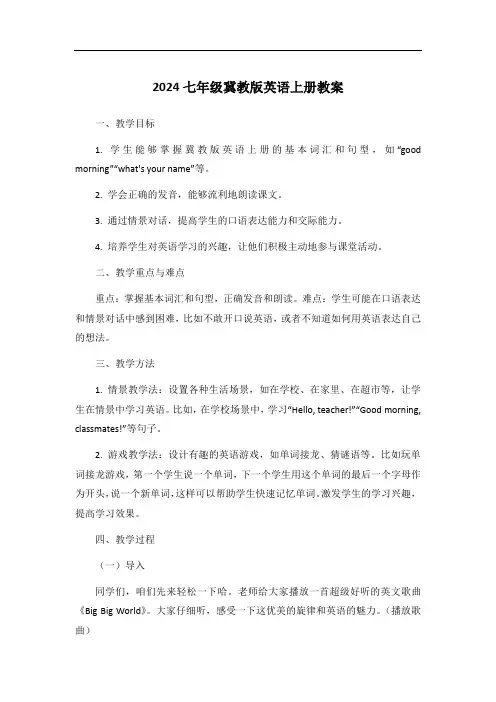
2024七年级冀教版英语上册教案一、教学目标1. 学生能够掌握冀教版英语上册的基本词汇和句型,如“good morning”“what's your name”等。
2. 学会正确的发音,能够流利地朗读课文。
3. 通过情景对话,提高学生的口语表达能力和交际能力。
4. 培养学生对英语学习的兴趣,让他们积极主动地参与课堂活动。
二、教学重点与难点重点:掌握基本词汇和句型,正确发音和朗读。
难点:学生可能在口语表达和情景对话中感到困难,比如不敢开口说英语,或者不知道如何用英语表达自己的想法。
三、教学方法1. 情景教学法:设置各种生活场景,如在学校、在家里、在超市等,让学生在情景中学习英语。
比如,在学校场景中,学习“Hello, teacher!”“Good morning, classmates!”等句子。
2. 游戏教学法:设计有趣的英语游戏,如单词接龙、猜谜语等。
比如玩单词接龙游戏,第一个学生说一个单词,下一个学生用这个单词的最后一个字母作为开头,说一个新单词,这样可以帮助学生快速记忆单词。
激发学生的学习兴趣,提高学习效果。
四、教学过程(一)导入同学们,咱们先来轻松一下哈。
老师给大家播放一首超级好听的英文歌曲《Big Big World》。
大家仔细听,感受一下这优美的旋律和英语的魅力。
(播放歌曲)好啦,歌曲听完了。
同学们,这首歌好不好听呀?(学生回答:好听。
)那大家有没有注意到歌曲里的一些英语单词和句子呢?(学生回答各种听到的单词和句子。
)非常棒!今天呀,我们就一起走进冀教版英语上册的奇妙世界,去探索更多有趣的英语知识。
(二)知识讲解1. 课本原文内容展示(以第一单元为例)“Hello! I'm Li Ming. Nice to meet you!”“Hi! I'm Jenny. Nice to meet you, too!”同学们,咱们来看这句话“Hello! I'm Li Ming. Nice to meet you!”这句话是什么意思呢?(学生回答:你好!我是李明。
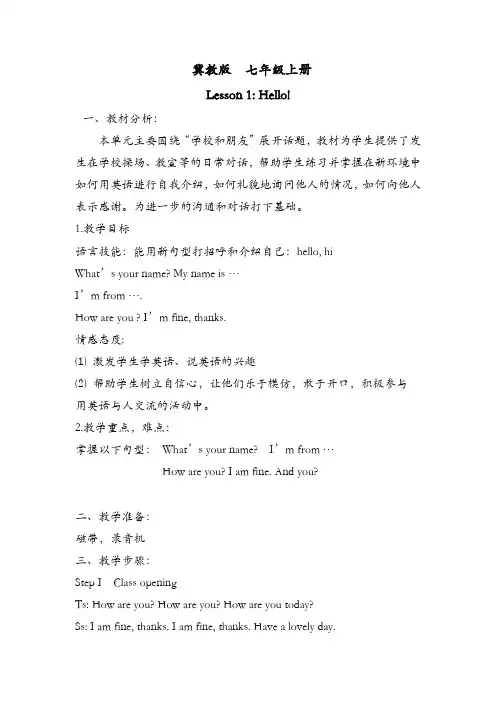
冀教版七年级上册Lesson 1: Hello!一、教材分析:本单元主要围绕“学校和朋友”展开话题,教材为学生提供了发生在学校操场、教室等的日常对话,帮助学生练习并掌握在新环境中如何用英语进行自我介绍,如何礼貌地询问他人的情况,如何向他人表示感谢。
为进一步的沟通和对话打下基础。
1.教学目标语言技能:能用新句型打招呼和介绍自己:hello, hiWhat’s your name? My name is …I’m from ….How are you ? I’m fine, thanks.情感态度:⑴激发学生学英语、说英语的兴趣⑵帮助学生树立自信心,让他们乐于模仿,敢于开口,积极参与用英语与人交流的活动中。
2.教学重点,难点:掌握以下句型:What’s your name? I’m from …How are you? I am fine. And you?二、教学准备:磁带,录音机三、教学步骤:Step I Class openingTs: How are you? How are you? How are you today?Ss: I am fine, thanks. I am fine, thanks. Have a lovely day.Ts: How are you? How are you? How are you today?Ss: I am fine, thanks. I am fine, thanks. Have a lovely day.(设计思路:通过歌曲以轻松愉快的方式进入英语学习,教师要带动学生,通过身体和表情号召学生加入到以歌曲打招呼的活动中来)Step II New conceptsHello! Hi! My name is ….教师拉起一位学生,“Hi”打招呼,边和学生握手,边指自己说My name is … . What is your name? 让学生模仿并介绍自己,并以游戏方式传递进行。
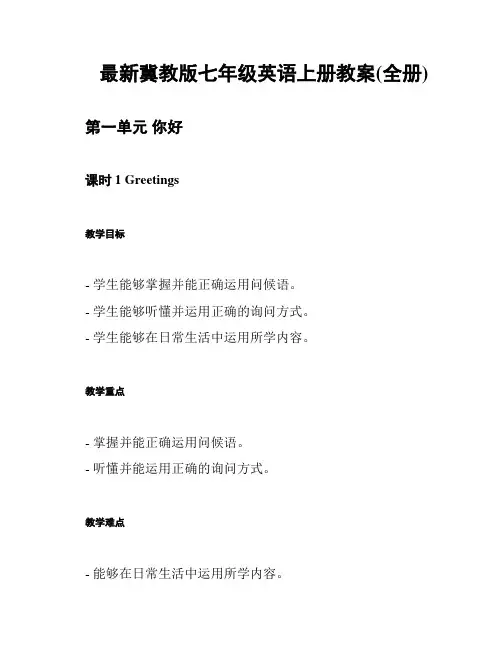
最新冀教版七年级英语上册教案(全册)第一单元你好
课时1 Greetings
教学目标
- 学生能够掌握并能正确运用问候语。
- 学生能够听懂并运用正确的询问方式。
- 学生能够在日常生活中运用所学内容。
教学重点
- 掌握并能正确运用问候语。
- 听懂并能运用正确的询问方式。
教学难点
- 能够在日常生活中运用所学内容。
教学准备
- Pictures, video, or a PPT of different people saying hello in different cultures and different situations.
- A recorder or ways to record students’ pronunciation.
教学过程
1. 板书文字 Greetings 和 How do you do?
2. 老师出示图片或视频,让学生看不同文化及情景下的问候,让学生了解问候有不同的方式和表达。
3. 让学生组成两人小组,互相问候,教师在组内行走,逐一点评。
4. 请学生分组模仿录音,然后老师播放录音,检查并纠正他们的发音。
5. 鼓励学生运用所学内容在日常生活中练。
课堂小结
本堂课学生们学了打招呼的方式和正确发音。
课后作业
1. 编写对话表格,要求:两人以上,使用本节课学过的问候语和发音。
要求流畅,语音正确。
2. 练习对话表格中的对话,准备口头演出。
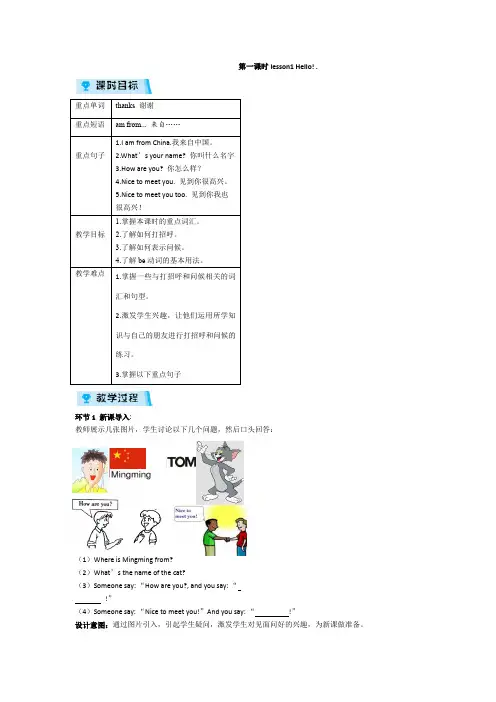
第一课时lesson1 Hello! .环节1 新课导入:教师展示几张图片,学生讨论以下几个问题,然后口头回答:(1)Where is Mingming from? (2)What ’s the name of the cat?(3)Someone say: “How are you?, and you say: “ !”(4)Someone say: “Nice to meet you!”And you say: “ !”设计意图:通过图片引入,引起学生疑问,激发学生对见面问好的兴趣,为新课做准备。
环节2 学习活动1.听录音,听完讨论并口头回答以下问题:(1)Where is Danny from?(2)How is Li Ming?2.教师教读本课的对话内容,然后同桌一起练习,熟读对话。
3.教师请几对同学起来表演。
指出学生表现得好的地方和不足之处,要适当鼓励。
4.听练习题1的录音,大家跟着录音一起唱。
5.学生四人为一组,编对话,相互询问对方的姓名,国籍等问题。
对话中要用到下列句子:What’s your name?How are you?Where are you from?Nice to meet you.6.教师请三组学生起来表演他们的对话,然后作点评。
表现得好的小组获得奖励。
7.教师随机抽取四名学生到讲台上表演,参照练习题2的游戏进行对话,教师在一边指导和配合表演。
8.学生完成练习题3,按打招呼的正确顺序,题中的三句话排序。
9.学以致用。
(1)同义句转换:I am Jenny.My name is Jenny.(2)用be的正确形式完成对话。
Joe: Hello. I am Joe. What is your name?Sue:My name is Sue.(3)根据句意完成对话。
Joe: Hi,nice to meet you!Sue:Hi, nice to meet you, too.设计意图:通过简单的自我介绍练习和日常见面打招呼的方式,让学生初步学会如何用英语介绍自己、问候对方。
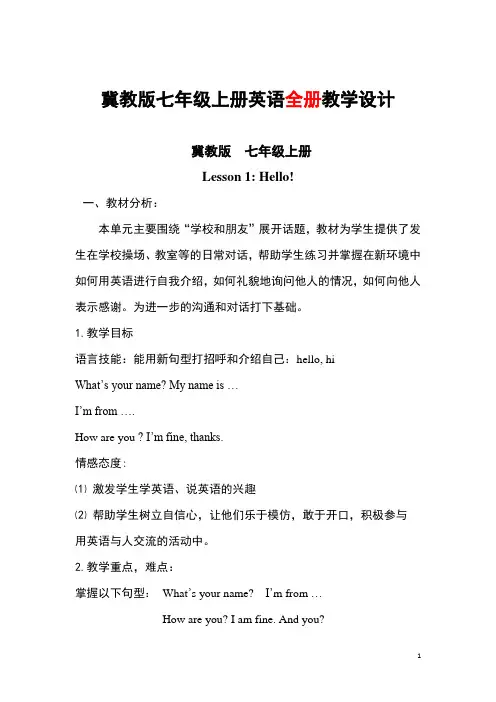
冀教版七年级上册英语全册教学设计冀教版七年级上册Lesson 1: Hello!一、教材分析:本单元主要围绕“学校和朋友”展开话题,教材为学生提供了发生在学校操场、教室等的日常对话,帮助学生练习并掌握在新环境中如何用英语进行自我介绍,如何礼貌地询问他人的情况,如何向他人表示感谢。
为进一步的沟通和对话打下基础。
1.教学目标语言技能:能用新句型打招呼和介绍自己:hello, hiWhat’s your name? My name is …I’m from ….How are you ? I’m fine, thanks.情感态度:⑴激发学生学英语、说英语的兴趣⑵帮助学生树立自信心,让他们乐于模仿,敢于开口,积极参与用英语与人交流的活动中。
2.教学重点,难点:掌握以下句型:What’s your name? I’m from …How are you? I am fine. And you?二、教学准备:磁带,录音机三、教学步骤:Step I Class openingTs: How are you? How are you? How are you today?Ss: I am fine, thanks. I am fine, thanks. Have a lovely day.Ts: How are you? How are you? How are you today?Ss: I am fine, thanks. I am fine, thanks. Have a lovely day.(设计思路:通过歌曲以轻松愉快的方式进入英语学习,教师要带动学生,通过身体和表情号召学生加入到以歌曲打招呼的活动中来)Step II New conceptsHello! Hi! My name is ….教师拉起一位学生,“Hi”打招呼,边和学生握手,边指自己说My name is … . What is your name? 让学生模仿并介绍自己,并以游戏方式传递进行。

冀教英语七上教案8篇冀教英语七上教案篇1让我们说hello【活动目标】1、能知道问候的基本用语hello,hi,how are you.等,并且知道礼貌回答。
2、清晰,正确发音,语调合适,有良好的语感。
3、感受问候的不同场合和方法,通过学会问候进一步培育个人礼貌和修养。
【活动预备】1、一段打招呼的音频。
2、动物头饰。
【活动过程】一、引入话题。
师:“小伙伴们,老师问你们个问题啊,在你们每天见到老师的时候,都会说什么?”让小伙伴回答。
回答之后,老师切入话题“好的,那今日我们就来学学,如何用英语打招呼,问候别人,好吗?来,我们先听听别人是怎么打招呼的。
”二、播放音频。
播放到一个语句就停下,请小伙伴回答别人是怎么打招呼的。
例如播放到hello,*iaoming。
停下,引导小伙伴知道别人是通过说hello打招呼的。
然后老师示范正确发音“hello”请小伙伴一个一个发音。
紧接着播放“hi,*iaohua.”接着引导小伙伴通过回答“hi”来回应别人。
亦示范正确发音。
三、插入小游戏:向小伙伴说hello。
每个小伙伴选择自己喜爱的动物头饰戴上,然后扮演动物相互打招呼。
例如小猫向小狗打招呼“喵,hello.”“hi,汪汪.”四、继续播放音频,以同样方法学习“how are you”及回答方式。
角色扮演打招呼“how are you”“fine,thank you”等。
五、请小伙伴回忆什么时候需要打招呼,需要和谁打招呼。
然后情景再现,扮演打招呼的场面,进一步巩固所学的打招呼方式和回答。
冀教英语七上教案篇2教学目标:1、培育同学自主参加语言实践活动,在活动中树立英语学习的信心,加强同学对英语学习的爱好。
2、培育同学听、说、读的技能以及交际的技能。
3、去掌控问路和指路的句型。
教学重点:to practice the dialogue教学难点:act the dialogues教学方法:1.情景教学法2.自主学习合作探究教学预备:多媒体录音机教学过程:一、新课导入情景导入对话1.迷路了,怎么办?是否有过问路或是为别人指路的经受。

冀教版七年级上册Lesson 1: Hello!一、教材分析:本单元主要围绕“学校和朋友”展开话题,教材为学生提供了发生在学校操场、教室等的日常对话,帮助学生练习并掌握在新环境中如何用英语进行自我介绍,如何礼貌地询问他人的情况,如何向他人表示感谢。
为进一步的沟通和对话打下基础。
1.教学目标语言技能:能用新句型打招呼和介绍自己:hello, hiWhat’s your name? My name is …I’m from ….How are you ? I’m fine, thanks.情感态度:⑴激发学生学英语、说英语的兴趣⑵帮助学生树立自信心,让他们乐于模仿,敢于开口,积极参与用英语与人交流的活动中。
2.教学重点,难点:掌握以下句型:What’s your name? I’m from …How are you? I am fine. And you?二、教学准备:磁带,录音机三、教学步骤:Step I Class openingTs: How are you? How are you? How are you today?Ss: I am fine, thanks. I am fine, thanks. Have a lovely day.Ts: How are you? How are you? How are you today?Ss: I am fine, thanks. I am fine, thanks. Have a lovely day.(设计思路:通过歌曲以轻松愉快的方式进入英语学习,教师要带动学生,通过身体和表情号召学生加入到以歌曲打招呼的活动中来)Step II New conceptsHello! Hi! My name is ….教师拉起一位学生,“Hi”打招呼,边和学生握手,边指自己说My name is … . What is your name? 让学生模仿并介绍自己,并以游戏方式传递进行。
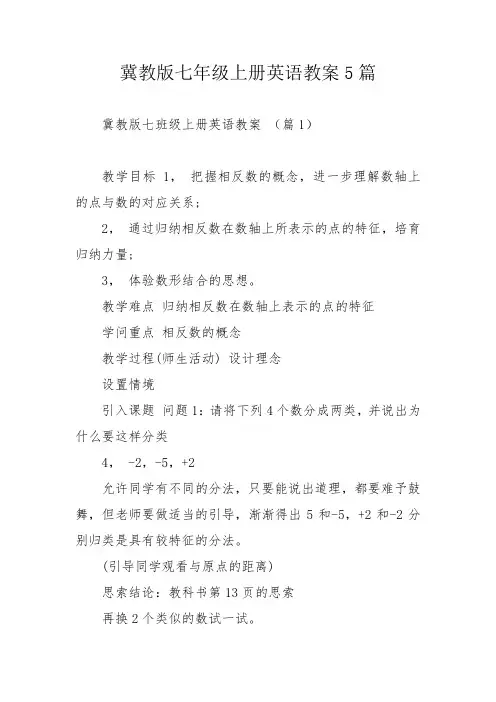
冀教版七年级上册英语教案5篇冀教版七班级上册英语教案(篇1)教学目标 1,把握相反数的概念,进一步理解数轴上的点与数的对应关系;2,通过归纳相反数在数轴上所表示的点的特征,培育归纳力量;3,体验数形结合的思想。
教学难点归纳相反数在数轴上表示的点的特征学问重点相反数的概念教学过程(师生活动) 设计理念设置情境引入课题问题1:请将下列4个数分成两类,并说出为什么要这样分类4, -2,-5,+2允许同学有不同的分法,只要能说出道理,都要难予鼓舞,但老师要做适当的引导,渐渐得出5和-5,+2和-2分别归类是具有较特征的分法。
(引导同学观看与原点的距离)思索结论:教科书第13页的思索再换2个类似的数试一试。
归纳结论:教科书第13页的归纳。
以开放的形式创设情境,以同学进行争论,并培育分类的力量培育同学的观看与归纳力量,渗透数形思想深化主题提炼定义给出相反数的定义问题2:你怎样理解相反数定义中的“只有符号不同”和“互为”一词的含义?零的相反数是什么?为什么?同学思索争论沟通,老师归纳总结。
规律:一般地,数a的相反数可以表示为-a思索:数轴上表示相反数的两个点和原点有什么关系?练一练:教科书第14页第一个练习体验对称的图形的特点,为相反数在数轴上的特征做预备。
深化相反数的概念;“零的相反数是零”是相反数定义的一部分。
强化互为相反数的数在数轴上表示的点的几何意义给出规律解决问题问题3:-(+5)和-(-5)分别表示什么意思?你能化简它们吗?同学沟通。
分别表示+5和-5的相反数是-5和+5练一练:教科书第14页其次个练习利用相反数的概念得出求一个数的相反数的方法小结与作业课堂小结 1,相反数的定义2,互为相反数的数在数轴上表示的点的特征3,怎样求一个数的相反数?怎样表示一个数的相反数?本课作业 1,必做题教科书第18页习题1.2第3题2,选做题老师自行支配本课教育评注(课堂设计理念,实际教学效果及改进设想)1,相反数的概念使有理数的各个运算法则简单表述,也揭示了两个特别数的特征.这两个特别数在数量上具有相同的肯定值,它们的和为零,在数轴上表示时,离开原点的距离相等等性质均有广泛的应用.所以本教学设计围绕数量和几何意义绽开,渗透数形结合的思想.2,教学引人以开放式的问题人手,培育同学的分类和发散思维的力量;把数在数轴上表示出来并观看它们的特征,在复习数轴学问的同时,渗透了数形结合的数学方法,数与形的相互转化也能加深对相反数概念的理解;问题2能关心同学精确把握相反数的概念;问题3实际上给出了求一个数的相反数的方法.3,本教学设计体现了新课标的教学理念,同学在老师的引导下进行自主学习,自主探究,观看归纳,重视同学的思维过程,并给同学留有发挥的余地.冀教版七班级上册英语教案(篇2)教学目的1.通过对多个实际问题的分析,使同学体会到一元一次方程作为实际问题的数学模型的作用。
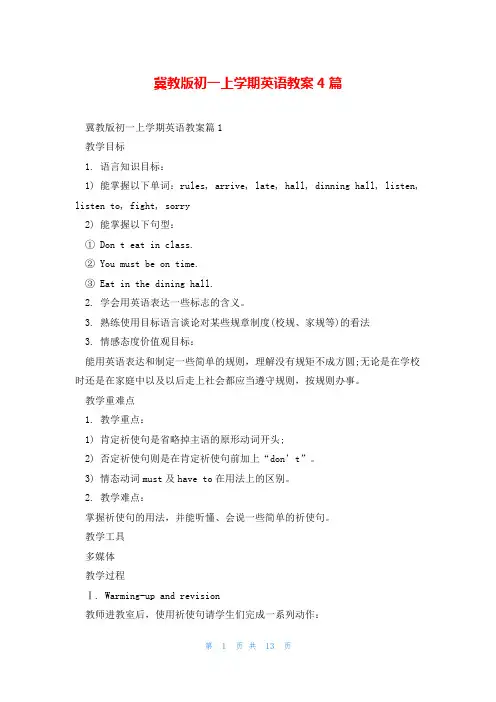
冀教版初一上学期英语教案4篇冀教版初一上学期英语教案篇1教学目标1. 语言知识目标:1) 能掌握以下单词:rules, arrive, late, hall, dinning hall, listen, listen to, fight, sorry2) 能掌握以下句型:① Don t eat in class.② You must be on time.③ Eat in the dining hall.2. 学会用英语表达一些标志的含义。
3. 熟练使用目标语言谈论对某些规章制度(校规、家规等)的看法3. 情感态度价值观目标:能用英语表达和制定一些简单的规则,理解没有规矩不成方圆;无论是在学校时还是在家庭中以及以后走上社会都应当遵守规则,按规则办事。
教学重难点1. 教学重点:1) 肯定祈使句是省略掉主语的原形动词开头;2) 否定祈使句则是在肯定祈使句前加上“don’t”。
3) 情态动词must及have to在用法上的区别。
2. 教学难点:掌握祈使句的用法,并能听懂、会说一些简单的祈使句。
教学工具多媒体教学过程Ⅰ. Warming-up and revision教师进教室后,使用祈使句请学生们完成一系列动作:Please stand up/ sit down. Close the door, please. Look at me and listen to me.Don’t open your books. Don’t talk. Let’s begin our clas s.学生听教师的指令完成各种动作,教师也可将指令写到黑板上,让学生从视觉上考察祈使句的特点。
Ⅱ. Presentation教师出示书上1a 的图片,向学生提问。
指着图上奔跑的男孩提问T:What’s the boy doing S: He’s running.T: Where is he running S: He’s running in the hallways.(板书,教读)T:Can you run in the hallways S: No, I can’t.T: So please don’t run in the hallways.(板书,教读)(= You can’t run in the hallways.)学生跟读数遍,明白祈使句和“can”的表达含意。
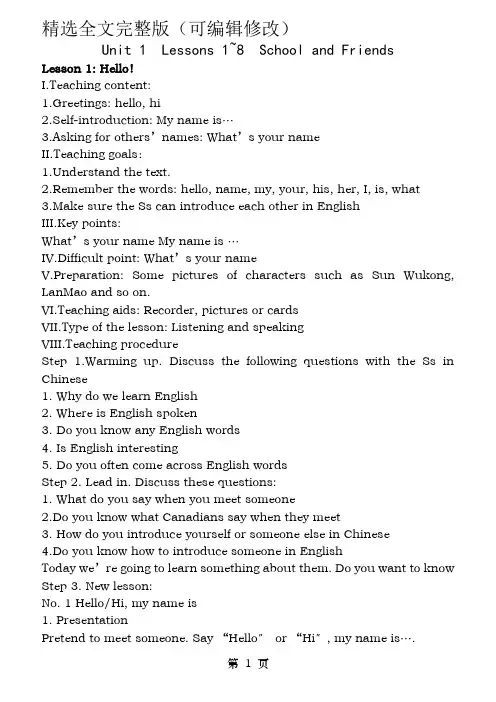
精选全文完整版(可编辑修改)Unit 1 Lessons 1~8 School and FriendsLesson 1: Hello!I.Teaching content:1.Greetings: hello, hi2.Self-introduction: My name is…3.Asking for others’names: What’s your nameII.Teaching goals:1.Understand the text.2.Remember the words: hello, name, my, your, his, her, I, is, what3.Make sure the Ss can introduce each other in EnglishIII.Key points:What’s your name My name is …IV.Difficult point: What’s your nameV.Preparation: Some pictures of characters such as Sun Wukong, LanMao and so on.VI.Teaching aids: Recorder, pictures or cardsVII.Type of the lesson: Listening and speakingVIII.Teaching procedureStep 1.Warming up. Discuss the following questions with the Ss in Chinese1. Why do we learn English2. Where is English spoken3. Do you know any English words4. Is English interesting5. Do you often come across English wordsStep 2. Lead in. Discuss these questions:1. What do you say when you meet someone2.Do you know what Canadians say when they meet3. How do you introduce yourself or someone else in Chinese4.Do you know how to introduce someone in EnglishToday we’re going to learn something about them. Do you want to know Step 3. New lesson:No. 1 Hello/Hi, my name is1. PresentationPretend to meet someone. Say “Hello〞o r “Hi〞, my name is….Make sure the Ss can understand it. Encourage them to repeat.2. PracticeWork in pairs. Encourage the Ss to greet each other and introduce themselves. Then ask some pairs to act it out.No. 2. What’s your name1. PresentationSay “My name is___. What’s your name〞Translate if necessary. Then repeat a few times. Encourage the Ss to follow until they can say it correctly.2. PracticeWork in chain like this:A: (to B) My name is ___. What’s your nameB: My name is ___. (to C) What’s yo ur nameC: …Then ask some Ss to act it out.3.Listen and follow4. Play the tape for the Ss to follow.5.Summary.Sum up the lesson briefly by practicing all the dialogues in the text. Read the text and practice the dialogue.Teaching reflection:Lesson 2: How Are YouI.Teaching content1.Greeting: Nice to meet you2.Teach the song “How Are You〞II.Teaching goals1.Understand the text2.Remember the mastery vocabulary3.Understand and sing the song “How are you〞III.Key points: Greet someone with the phra se “How are you〞IV.Difficult point: greeting and response in the text1.Prepare some pictures and put them on the Bb2.Write the new words on the BbVI.Teaching aids: audiotape and some picturesVII.Type of the lesson: listening, speaking and singingVIII.Teaching procedureStep 1. Warming up. Greeting and review. After greeting (Hi, Hello), review the dialogue in the last lesson briefly.Step 2. Lead in. Ask the Ss the questions in Chinese:1.What do Chinese say when they meet each other2.Canadians don’t ask the questions such as “Have you had your meal〞or “Where are you going〞. Do you know what they say expect “Hi〞or “Hello〞Step 3. New lesson1.Presentation. Explain that Canadians greet each other by saying “How are you〞and “Nice to meet you〞. Explain the meaning of the expressions. Encourage the Ss to repeat a few times.2.Listen and say. Play the tape for the Ss to follow.3.Practice. Work in pairs. Encourage the Ss to practice the dialogue in pairs. Demonstrate the dialogue with one or two Ss, and then ask some pairs to act it out for the rest of the class.Step 4. Demonstrate and practice the dialogue:Hello! My name is ___. What’s your nameMy name is ____ .Nice to meet you.Nice to meet you, too.Step 5. Teach the song “How are you〞1.Go over the words of the song and practice them.2.Explain the last line3.Play the song for the Ss to follow.Step 6. Summary. Sum up the greeting and response, combining with the useful expressions in this lesson.Step 7. Homework.1.Read and practice the dialogue.2.Sing the song “How Are You〞Teaching reflection:Lesson3: My FriendsI.Teaching content1. Introducing others: He/she is my friend.2.What’s her/his nameII.Teaching goals1.Understand the text2.Remember the mastery vocabulary: boy, girl, teacher,III.Key point: He/she is my friend.IV.Difficult point: plural forms of the nouns1.Prepare some pictures and put them on the Bb2.Write the new words on the BbVI.Type of the lesson: listening, speaking, readingVII.Teaching resources: audio tape, pictures in the classroomVIII.Teaching procedureIX.Teaching procedure Design for activitiesSay “Hello, how are you〞make the Ss respond correctly. Then sing the song “ How are you〞Step 2. Teach the new words boy, girl, and teacher by pointing a girl/boy/yourself or pictures. Explain the sentence “This is a _____〞. Step 3. Let the Ss to practice “This is a ____〞by pointing at someone. Step 4. Use the pictures to teach the new words: chair, book. Demonstrate “ What’s this It’s a ___〞. Then practice them with the Ss.Step 5. Teach the numbers one –five, using your fingers to show the meaning. Then use the books on the desk to demonstrate. Pay attention to the plural of the word “book〞.Step 6.Encourage the S to practice the number by pointing boys, girls, desks, chairs, and books. Then ask some Ss o do this in front of the class. Step 7. Sum up the items brieflyStep 8. HomeworkRead the text. Try to use the items in the classroomTeaching reflection:Lesson 4: My SchoolI.Teaching content1.This is my school.2.New words: school,classroom, lab,library3.Letters Aa—DdII.Teaching aims1.Understand the text.2.Remember the words: school, classroom, lab,library3.Sing the song.III.Key point: This is____IV.Difficult point: the words of the songV.Preparation before class1.Some pictures of school, classroom and library2.Write the new words on the BbVI.Type of the lesson: listening, speaking, response and singingVII.Teaching aids: audiotape, picturesVIII.Teaching procedureStep1.Warming up1.Greeting. Greet the Ss with the expressions in L1 and L22.Sing the song “How are you〞3.Review the item “This is a _____.〞and “What’s this〞by pointing something4.Count the numbersUse pictures to teach the words “school,classroom, lab and library〞. Step 3. Practice. Encourage the Ss to practice in pairs, using books, chairs, desks, etc. Play the tape for the Ss to follow. Then ask someone to demonstrate for the rest of the class.Step 4. Sum up the text briefly to consolidate the items. Play “Hide –and –search〞ga me to review “Where is___〞Step 5. Homework1.Read the text2.Sing the songTeaching reflection:Lesson 5 : My ClassroomI. Teaching content1.New words: pen, pencil, pencil case, marker, blackboard2.What’s this It’s a _____.3.How many ____ do you haveII.Teaching aims1.Understand the text2.Remember the new words3.Ask and answer about “ How many____〞III. Key points1.What’s this2.How many___IV. Difficult points: The question “How many___〞And the answers V. Preparation1.Prepare some pictures of school, classroom and library2.Bring some real things such as pen, pencil, pencil case and marker VI.Teaching aids: audiotape, some pictures, books, pens, pencils and markersVII.Type of the lesson: Listening and speakingVIII.Teaching procedureStep 1. Warming up. Greet the Ss and review the last lesson. Ask some pairs to act out the dialogue like this:A: What’s thisB: It’s a ____.(Using old words)Step 2. PresentationUse real objects or pictures to teach the new words. Write them on the blackboard. Play the tape for the Ss to follow.Step 3. Practice.Encourage the Ss to practice “What’s this〞“It’s a ___, (using new words). Then ask some pairs to act it out, using real things or pictures. Step 4. PresentationHold up three pens and say “How many〞a few times. Make sure the Ss understand it. Introduce in this way: How many →How many pencils How many pencils do you haveStep 5. PracticeLet the Ss work in pairs. Lead them to practice like this:A: Do you have any ___B: Yes/No.A: How many ___ do you haveB: _____.Play the tape for the Ss to follow. Ask some pairs to act it out.Step 6. Presentation: go over the words of the song1.Do actions to demonstrate jump, look, point, reach, sit and stand, adding up and down. e.g. look up/down.2.TPR activitie s. Demonstrate “order and response〞with one student. Say “stand up, look up〞and so on, and encourage the student to respond. Then do the same with the rest of the class.3.Practice. Work in pairs. One gives the orders and the other do the actions.4.Go over the words of the song. Make sure the Ss understand them.5.Chant and sing.①Play the tape for the Ss to follow.②Practice in pairs③Do it togetherStep 7. SummaryReview the new words and the drill. Sum up them briefly.Step 8. Homework1. Read the text and practice the dialogue.2.Finish the activity book.Teaching reflection:Lesson6: How Many BooksI.Teaching content1.Letters Ii—Ll2.Number one—fiveII.Teaching aims1.Understand the text2.Master the letters: Ii Jj Kk Ll3.Master the drillsIII. Key point:1.The letters A---G2.This is____. She is ____.IV.Difficult point: words of the song2.Bring some real objects such as a book, an eraser, a pen, a pencil, a pencil case, a marker etc.3.Some pictures of fish, door, girl, boy, teacherVI.Teaching aids: audiotape, letter cards, picturesVII.Type of the lesson: listening, speaking and singingVIII.Teaching procedureStep 1.Warming up. Greet the Ss by saying “Good morning/afternoon. How are you today〞Encourage the Ss to replyStep 2.Review the dr ill “What’ this It’s a ____.〞and “How many___〞Tell the Ss that English words are made up of letters and that English alphabet has 26 letters. Each letter has two sizes. Generally speaking, every letter makes a sound. e.g. the letter B makes a [b] sound in the word book. Demonstrate A→apple, using s picture of an apple. Then present the rest letters in the same way. Play the tape for the Ss o follow. Step 4. Practicee the cards to practice the letters and words in this lesson. Write the letters on the Bb. The letters have arrows that show how, and in what sequences to make the strokes. On the Bb, show the Ss how to follow he arrows to write each letter. Then let the Ss practice writing them.2.Work in pairs like this:What’s thisIt’s A/B/an apple.Ask some pairs to ct it outStep 5. The “ABC song〞1.Go over the words of the song2.Play the tape for the Ss to followStep 6. Presentation1.Teach the meaning of the word friend and he/she2.Point to a boy/ girl and say, “ This is ____ (name). He /she is my friend. Repeat it a few times. Explain the meaning if necessary.Step 7. Practice1.Play the tape for the Ss to follow2.Work in pairs or groups. Practice the dialogue. Then ask some pairs or groups to act it out.Step 8. Summary1.Sum up the letters and words by showing cards and pictures2.Sum up the way of introducing someoneStep 9. Homework1.Read the text2.Practice writing the letters3.Sing the song4.Act out the dialogue.Say “good-bye/see you later〞when closing the class.Teaching reflection:Lesson 7: May I _______I.Teaching content1.The letters Mm—Ppe the expressions “May I have/borrow____〞to ask for something.3.Request or orders: Open the___, close the____.II.Teaching goals1.Understand the meaning of the text2.Master the letters H I J K L M N3.Ask for something in Englishe the Phrase “ Open/close the ____.〞III.Key point:2.Asking for somethingIV.Difficult point: borrowing things1.Make letter cards or this lesson2.Bring real things such as books, pens, markers and so onVI.Teaching aids: audiotape, cards, some books and pensVII.Type of the lesson: Listening and speakingVIII.Teaching procedureStep 1.Warming up.1.Greeting and review. Review the letters and words of the last lesson by using cards.2. Sing the ABC song3. Ask some pairs to act out the dialogue of the last lessonStep 2.Introducing the new letters in the same way shown in the last teaching design, using pictures. Show the Ss how to write the letters. Step 3 Practice and production.1. Play the tape for the Ss to follow2. Practice in pairs. Encourage the Ss to ask for real things like books, pens, marker, erasers etc.3. Ask some pairs to act it outStep 4.L7 N3. Teach “May I have_____, please〞working from old phrases to new ones and adding the replies “Sure! Here you are.〞And “You’re welcome〞. Use actions to make your meaning clear. Translatewhen necessary.Step 5.Summary. Sum up the text briefly1. Read the text.2. Practice writing the letters3. Practice the dialogueTeaching reflection:Lesson 8 :Unit ReviewI.Teaching content1.Review the words and expression in this unit2.Grammar: the verbs am and is3.Exercise in the lessonII.Teaching goals1.Master the drills in this unit2.Master the letters A—NIII.Key points: Expressions and grammarIV.Difficult point: Grammar1.Bring the letter cards2.Bring real things to review the words3.Prepare some pictures to review the drillsVI.Teaching aids: Letter cards and some picturesVII.Type of the lesson: ReviewVIII.Teaching procedureStep 1.Review the letters and sing the ABC song.Step 2.Listen to the song “Ten little Indians〞and review the numbers 1—10.Step 3.Review the greeting “How are you〞and sing the song about it. Step e real things and cards to review the expressions in this unit.e.g.A: What’s thisB: It’s a ____.C: How many ____ do you haveD: I have ____.E: Where is the ____Step 5. Combine the dialogues in this unit and encourage the Ss to practice:Hello!Hi! My name is ____. What’s your nameMy name is____.Nice to meet you!Nice to meet you too.How are youFine, thank you. How are youI’m fine, thanks.Where is ____There!May I have/borrow _____Sure. Here you are.Thanks.You’re welcome.Or play the chain game to practice them. Then finish N4 of this lesson.. Step 6. Grammar. T he verb “be〞1. Introduction.Let the Ss tell you some sentences that include “is〞and “are〞. Encourage them to sum up the usage of the two words. Then sum up. 2. Practice. Complete the conversation in L8 N2. to practice using them. If time is enough, have a short test.Step 7. HomeworkTell the Ss to review all the text in this unit. try to use the expressions about greetings, introductions, giving thanks and saying Good-bye in their daily life.Teaching reflection:Unit 2 Lessons 9~16Colours and ClothesLesson 9 Red, Yellow, BlueI.Teaching content1. six letters: Oo, Pp, Qq, Rr, Ss, Tt2. three colours: red, yellow, blue3. drill: What colour is itII.Teaching aims:1.Understand the meaning of the text2.Remember the mastery vocabulary (Pp, Qq, Rr, Ss, Tt, red, yellow, blue)3.Master the drill: What colour is itIII.Teaching important points:1.Six letters2.Three colours3.Plural form of nounIV.Teaching difficult point: plural form of nounV.Preparation: letter cards, three markers, two apples, and some real things.VI.Teaching aids: audiotape, some real things, letter cards and some markersVII.Type of the lesson: letters lessonVIII.Teaching procedureWarming up1.Greet in everyday English and make sure the Ss can respond in correct way.2.Review all the words and letters the class has learned so far, using cards, pictures or real things.New lessonStep 1. No. 1. Review the letters A—N, using alphabet poster. Show cards with different letters to the Ss and make sure they read the letters correctly. Write the words on the Bb or show letters cards and read the letters for the Ss to follow. And then teach the words with the letter cards in it.Step 2. Show word cards and teach orange, paper, queen, rose, school and tea. Make sure the Ss understand the meaning.Step 3. Play the tape for the Ss to followStep 4. Write the letters on the Bb. The letters have arrows that show how to make the strokes. On the Bb, show the students how to follow the arrows to write the words.Step 5. Hold up red, yellow and blue markers as you say the colours. Then write the words red, yellow, blue on the Bb. Make sure the Ss understand their meanings. Using real things in the classroom to practice the drill “What colour is it〞Step 6. Play the tape for the Ss to follow.Step 7. Practice in pairs, using red, yellow or blue things:---- What colour is this---- It is _____.---- How many colours are thereStep 7. Activity book.No. 1. Fill in the first letter of words that begin with O, P, Q, R, S and T. No. 2. The Ss follow the directions to color the correct pictures. Teach the Ss the meaning of the verb by demonstrating on the Bb.Step 8. Homework1. Read the text in this lesson2. Practice the drills in pairs3. The remaining activities in the activity bookClass closing: Sing the ABC song.Teaching reflection:Lesson 10: Pink, Orange, Purple, GreenI.Teaching content1.Words: pink, orange, purple, green2.Drills: What are they How many colors do you likeII.Teaching aims:1.Understand the meaning of the text2.Understand the mastery words3.Master the plural form of nounIII.Key points: Colours and drill “How many….〞IV.Difficult Point: the plural form of nounV.Preparation: green, pink, orange, purple markers and real thingsVI.Teaching aids: recorder, some markers, and some other real things. VII.Type of the lesson: listening, speaking and writingVIII.Teaching ProcedureWarming up1.Greet in everyday English and make sure the Ss respond in correct way.2.Show an apple and other things and practice some drills as follows:---- What’s this----- It’s a ___.----- What colour is it----- It’s ____.----- Do you have any____.----- Yes/No.----- How many _____ do you haveNew lessonStep 1.No. 1. Demonstrate. Hold up a pink and say the word for the colour. Make sure the Ss understand the meaning and repeat it.You can say, “ This is pink〞or “ This colour is pink〞. Teach other words in the same way.Step 2.Play the tape for the Ss to follow.Step 3.Point to different things in the classroom which are pink, orange, purple or green, and practice the drill:---- What colour is this---- It’s _____.----- What colour are they----- They are____.Step 4.No. 2.What are theyDemonstrate. Hold up one marker and ask, “What is it〞the Ss will say “It’s a marker.〞Then hold up two markers and ask, “ What are they〞write the two sentences on the Bb. Point out the differences: it→they; is → are. Explain the differences. Then repeat the question, “What are they〞write “ two markers “ on the Bb. Pay attention to the “s〞after the word “ maker〞. Then teach three blue chairs in the same way. Make sure the Ss understand the difference between single form and plural form.Use pictures or real things to practice this part. Ask “ What are they〞and let the Ss answer.Step 6.Play the tape for the Ss to follow.Step 7.No. 3. How many colours do you likeDemonstrate. Hold up colour poster and say, “ I like blue and red. I like two colours. How many colours do you like〞make sure the Ss understand and respond correctly. Then practice.Step 8.Play the tape for the Ss to follow. Then pactice in pairs. Ask some pairs to act out it.Step 9.Summary. Sum up the lesson briefly.Step 10.Homework1.Read the text2.Practice writing the letters3.Practice the dialogue.Teaching reflection:Lesson 11 Black, White, BrownI.Teaching content1.Six letters: Uu, Vv, Ww, Xx, Yy, Zz.2.Colours: Black, white, brown3.Drill: What’s your favourite coloursII.Teaching aims:1.Understand the meaning of the text2.Remember the mastery vocabulary3.Answer t he questions to “ What’s your favorite colour〞III.Key points:1.Letters and colours in the lesson2.What’s your favourite colourIV.Difficult point: express your favorite, colourV.Preparation: letter cards, black, white and brown markers, some real things.VI.Teaching aids: audiotape, letter cards, some markers and some real things.VII.Type of the lesson: listening, speaking and writingVIII.Teaching procedureWarming up:1.Greetings.2.Review the drills。

冀教版七年级上册Lesson 1: Hello!一、教材分析:本单元主要围绕“学校和朋友”展开话题,教材为学生提供了发生在学校操场、教室等的日常对话,帮助学生练习并掌握在新环境中如何用英语进行自我介绍,如何礼貌地询问他人的情况,如何向他人表示感谢。
为进一步的沟通和对话打下基础。
1.教学目标语言技能:能用新句型打招呼和介绍自己:hello, hiWhat’s your name? My name is …I’m from ….How are you ? I’m fine, thanks.情感态度:⑴激发学生学英语、说英语的兴趣⑵帮助学生树立自信心,让他们乐于模仿,敢于开口,积极参与用英语与人交流的活动中。
2.教学重点,难点:掌握以下句型:What’s your name? I’m from …How are you? I am fine. And you?二、教学准备:磁带,录音机三、教学步骤:Step I Class openingTs: How are you? How are you? How are you today?Ss: I am fine, thanks. I am fine, thanks. Have a lovely day.Ts: How are you? How are you? How are you today?Ss: I am fine, thanks. I am fine, thanks. Have a lovely day.(设计思路:通过歌曲以轻松愉快的方式进入英语学习,教师要带动学生,通过身体和表情号召学生加入到以歌曲打招呼的活动中来)Step II New conceptsHello! Hi! My name is ….教师拉起一位学生,“Hi”打招呼,边和学生握手,边指自己说My name is … . What is your name? 让学生模仿并介绍自己,并以游戏方式传递进行。
冀教版初一上学期英语教案冀教版初一上学期英语教案4篇每个英语教师要高度重视英语学科教学,重视学生英语基础知识的学习和把握。
每个初一七班级英语老师都要写初一七班级英语教案,初一七班级英语教案能够提高他们的教学质量。
你是否在找正预备撰写“冀教版初一上学期英语教案”,下面我收集了相关的素材,供大家写文参考!冀教版初一上学期英语教案篇4教学目标1.学会不同工作的英文表达方式。
2.了解同学父母的工作。
3.学会简洁的介绍自己将来的抱负。
教学重难点重点词汇:teacher, nurse, engineer, manager, airhostess, lawyer, doctor, clerk, reporter, police重点句型:1. What does your mother do? She is a teacher.What does your father do? He is an engineer.2. What do you want to be? I want to be a teacher.What does she want to be? She wants to be a singer.教学工具多媒体教学过程Step One Warming activityHave some free talks.Ask students thesequestions:How many people are there in your family?Who are they?Do you love your family?Where’s your home?Step Two PresentationShow the picture of Pan Changjiang’s family. They are a happy family,learn the word “actor”.Actor is a job,do you know other jobs? Show the PPT, learn other newwords ,policeman,policewoman,doctor,nurse,waiterReporter,hospital ,ba nk clerk and so on.Do 1a as quickly as you can. Check the answers.Step Three New drillsT: I’m a teacher. (Ask one student What do you do?) Help the student answer I’m a student. Then ask several students.T: What do you do?S1: I’m a student.(Point to another boy)T: What does he do?S1: He is a student.T: What do you do?(Ask a girl)S2:I’m a student.(Point to this girl,ask another student)T:What does she do?S3:She is a student.T:What does your mother do?S4:She is a farmer.T:What does your father do?S4:He is a worker.Ask some Ss to answer the questions.Open your books,do 1b.Play the tape.Step 4 Task 1Make a survey and report about your group.Name Mother’s job Father’s jobStep 5 Task 2Play a guessing game.Step 6 Exercises1.I want to be a d_____ like Hua Tuo.2.My sister is a nurse,she works in ah_______.3.Cheng Long is a famous a____,Gong Li is afamous a_______.4.The two boys want to be __________(policeman)when they grow up.5.--What ___ you ___(do)? --I am a teacher.6.He is a shop assistant.(划线提问)____ ____ he ____?Step 7 Summary and HomeworkMake a survey ,ask your parents or three of your friends using the question” What do you want to be?” and fill in the chart.课后小结本节课的不足之处,由于本节课的内容较简洁,所以在各个任务环节的难度梯度不是很明显。
冀教版七年级上册英语全册教学设计冀教版七年级上册Lesson 1: Hello!一、教材分析:本单元主要围绕“学校和朋友”展开话题,教材为学生提供了发生在学校操场、教室等的日常对话,帮助学生练习并掌握在新环境中如何用英语进行自我介绍,如何礼貌地询问他人的情况,如何向他人表示感谢。
为进一步的沟通和对话打下基础。
1.教学目标语言技能:能用新句型打招呼和介绍自己:hello, hiWhat’s your name? My name is …I’m from ….How are you ? I’m fine, thanks.情感态度:⑴激发学生学英语、说英语的兴趣⑵帮助学生树立自信心,让他们乐于模仿,敢于开口,积极参与用英语与人交流的活动中。
2.教学重点,难点:掌握以下句型:What’s your name? I’m from …How are you? I am fine. And you?二、教学准备:磁带,录音机三、教学步骤:Step I Class openingTs: How are you? How are you? How are you today?Ss: I am fine, thanks. I am fine, thanks. Have a lovely day.Ts: How are you? How are you? How are you today?Ss: I am fine, thanks. I am fine, thanks. Have a lovely day.(设计思路:通过歌曲以轻松愉快的方式进入英语学习,教师要带动学生,通过身体和表情号召学生加入到以歌曲打招呼的活动中来)Step II New conceptsHello! Hi! My name is ….教师拉起一位学生,“Hi”打招呼,边和学生握手,边指自己说My name is … . What is your name? 让学生模仿并介绍自己,并以游戏方式传递进行。
七年级英语冀教版教案全册教案标题:七年级英语冀教版教案全册教案目标:1. 熟悉七年级英语冀教版教材内容,掌握每个单元的重点词汇和基本句型。
2. 培养学生的英语听、说、读、写的基本能力,提高学生的英语综合运用能力。
3. 培养学生的合作学习意识和团队合作能力,提高学生的学习兴趣和主动性。
教案内容:单元一:Hello!1. 学习目标:学习问候语及自我介绍。
2. 教学重点:学习问候语及自我介绍的句型。
3. 教学难点:能够灵活运用问候语和自我介绍进行交流。
4. 教学方法:情景教学法、合作学习法。
5. 教学准备:教材、多媒体课件、学生练习册。
6. 教学步骤:a. 导入新课:通过播放问候语的视频,引起学生兴趣。
b. 呈现新课:教师通过多媒体课件呈现问候语和自我介绍的句型,并进行示范。
c. 合作学习:学生分组进行角色扮演,练习使用问候语和自我介绍进行交流。
d. 拓展练习:教师出示图片,要求学生用英语进行描述。
e. 小结归纳:教师总结本课所学内容,强调重点。
f. 作业布置:要求学生完成课后练习册中的相关练习。
单元二:My Family1. 学习目标:学习家庭成员的称呼及家庭成员介绍。
2. 教学重点:学习家庭成员的称呼及家庭成员介绍的句型。
3. 教学难点:能够用英语介绍自己的家庭成员。
4. 教学方法:情景教学法、游戏教学法。
5. 教学准备:教材、多媒体课件、学生练习册、家庭成员图片。
6. 教学步骤:a. 导入新课:通过展示家庭成员图片,引起学生兴趣。
b. 呈现新课:教师通过多媒体课件呈现家庭成员的称呼及介绍的句型,并进行示范。
c. 游戏教学:教师设计家庭成员介绍的游戏,让学生在游戏中灵活运用所学内容。
d. 合作学习:学生分组进行家庭成员介绍的对话练习。
e. 拓展练习:教师出示图片,要求学生用英语进行家庭成员的描述。
f. 小结归纳:教师总结本课所学内容,强调重点。
g. 作业布置:要求学生完成课后练习册中的相关练习。
单元三:My School Life1. 学习目标:学习描述学校生活的词汇和句型。
冀教版英语七年级上册教案Lesson 1: GreetingsObjectives:- To introduce students to basic greetings in English- To develop students' speaking and listening skillsMaterials:- Flashcards with pictures of different greetings- CD playerProcedure:1. Greetings and Warm-up (5 minutes)- Greet the students and ask how they are doing.- Review any greetings that the students might already know in English.2. Introduction (10 minutes)- Show the flashcards with pictures of different greetings to the students.- Model each greeting and have the students repeat after you.- Ask the students to match the flashcards with the correct greetings.3. Listening Activity (15 minutes)- Play a recording of different greetings in English.- Have the students listen and repeat each greeting.- Ask the students to listen again and write down the greetings they hear.4. Speaking Activity (15 minutes)- Divide the students into pairs.- Ask the pairs to practice greeting each other using the greetings they have learned.- Monitor the pairs and provide feedback and assistance as needed.5. Consolidation (5 minutes)- Review the greetings as a class and have the students practice saying them again.- Ask the students to greet you and their classmates using the new greetings.6. Homework (5 minutes)- Ask the students to practice the greetings at home with their family and friends.- Write a short paragraph in English about their favorite greeting. Assessment:- Observe the students during the speaking activity and provide feedback on their pronunciation and use of the greetings.- Review the homework to assess the students' understanding of the greetings.Adaptation:- For students who are more advanced, introduce additional greetings and encourage them to create dialogues using the greetings.- For students who are struggling, provide additional examples and practice opportunities during the lesson.。
冀教版七年级上册Lesson 1: Hello!一、教材分析:本单元主要围绕“学校和朋友”展开话题,教材为学生提供了发生在学校操场、教室等的日常对话,帮助学生练习并掌握在新环境中如何用英语进行自我介绍,如何礼貌地询问他人的情况,如何向他人表示感谢。
为进一步的沟通和对话打下基础。
1.教学目标语言技能:能用新句型打招呼和介绍自己:hello, hiWhat’s your name? My name is …I’m from ….How are you ? I’m fine, thanks.情感态度:⑴激发学生学英语、说英语的兴趣⑵帮助学生树立自信心,让他们乐于模仿,敢于开口,积极参与用英语与人交流的活动中。
2.教学重点,难点:掌握以下句型:What’s your name? I’m from …How are you? I am fine. And you?二、教学准备:磁带,录音机三、教学步骤:Step I Class openingTs: How are you? How are you? How are you today?Ss: I am fine, thanks. I am fine, thanks. Have a lovely day.Ts: How are you? How are you? How are you today?Ss: I am fine, thanks. I am fine, thanks. Have a lovely day.(设计思路:通过歌曲以轻松愉快的方式进入英语学习,教师要带动学生,通过身体和表情号召学生加入到以歌曲打招呼的活动中来)Step II New conceptsHello! Hi! My name is ….教师拉起一位学生,“Hi”打招呼,边和学生握手,边指自己说My name is … . What is your name? 让学生模仿并介绍自己,并以游戏方式传递进行。
冀教版英语七年级上册教案教案标题:冀教版英语七年级上册教案教案目标:1. 帮助学生熟悉并掌握英语七年级上册的课文内容。
2. 培养学生的听、说、读、写的综合能力。
3. 培养学生的英语学习兴趣和自主学习能力。
教案大纲:第一课时:Unit 1 Hello!(1)教学目标:1. 学习并掌握新单词:hello, hi, goodbye, morning, afternoon, evening, night。
2. 学习并掌握日常问候用语:Hello! Hi! Goodbye! Good morning! Good afternoon! Good evening! Good night!3. 学习并掌握句型:Hello! Hi! Goodbye! Good morning! Good afternoon! Good evening! Good night!4. 能够用英语进行简单的问候和告别。
教学步骤:Step 1: Warm-up1. Greet the students with "Hello!" and ask them to respond.2. Play a "Hello" song or video to create a lively atmosphere.Step 2: Presentation1. Introduce the new words: hello, hi, goodbye, morning, afternoon, evening, night.2. Use pictures or gestures to help students understand the meanings of the new words.3. Teach the daily greetings: Hello! Hi! Goodbye! Good morning! Good afternoon! Good evening! Good night!4. Practice the pronunciation and intonation of the new words and phrases. Step 3: Practice1. Have students practice the greetings in pairs or small groups.2. Encourage students to greet each other using the new words and phrases.3. Monitor the students' pronunciation and provide feedback.Step 4: Production1. Ask students to create dialogues using the greetings and new words.2. Have some students perform their dialogues in front of the class.3. Provide feedback and praise for their efforts.Step 5: Consolidation1. Review the new words and phrases with the whole class.2. Play a game, such as "Simon Says," using the greetings and new words.3. Assign homework to reinforce the learning of the new words and phrases. 教学评估:1. 观察学生在练习中的表现,包括发音准确性和语言运用能力。
冀教版七年级英语上册教案全集Lesson 1 Hello一、Teaching content:1. Greetings: hello, hi2. Self-introduction: My name is…3.Asking for others’ names: What’s your/his/her name?二、Teaching goals1. Understand the text2.Remember the words: hello, name, my, your, his, her, I, is, what3. Make sure the Ss can introduce each other in English三、Key points:What’s your/his/her name?My /his/her name is …四、Difficult point: What’s his/her name?五、Preparation:A map of China and a map of Canada; some pictures of characters such as Sun Wukong, LanMao and so on.六、Teaching aids: Recorder, pictures or cards七、Type of the lesson: Listening and speaking八、Teaching procedureStep 1.Warming up. Discuss the following questions with the Ss in Chinese1. Why do we learn English?2. Where is English spoken?3. Do you know any English words?4. Is English interesting?5. Do you often come across English words?Step 2. Lead in. Discuss these questions:1. What do you say when you meet someone?2.Do you know what Canadians say when they meet?3. How do you introduce yourself or someone else in Chinese?4.Do you know how to introduce someone in English?Today we’re going to learn something about them. Do you want to know?Step 3. New lesson:No. 1 Hello/Hi, my name is1. PresentationPretend to meet someone. Say “Hello” or “Hi”, my name is….Make sure the Ss can understand it. Encourage them to repeat.2. PracticeWork in pairs. Encourage the Ss to greet each other and introduce themselves. Then ask some pairs to act it out.No. 2. What’ your/his/her name1. PresentationSay “My name is___. What’s your name?” Translate if necessary. Then repeat a few times. Encourage the Ss to follow until they can say it correctly.2. PracticeWork in chain like this:A: (to B) My name is ___. What’s your name?B: My name is ___. (to C) What’s your name?C: …Then ask some Ss to act it out.3. Presentation and practice: What’s his/ her name?Show a picture of LAN Mao and say, “What’s his name? His name is Lan Mao”. Ask the question and help the Ss to answer. Then repeat. Work in pairs to practice the dialogue and ask some pairs to act it out.4. Introduce the characters on the textbook: Li Ming, Jenny, and Danny. Teach the words China and Canada, using maps of them. Then explain the sentence “I live in___.”5.Listen and follow6. Play the tape for the Ss to follow.7.Summary.Sum up the lesson briefly by practicing all the dialogues in the text.8. HomeworkRead the text and practice the dialogue.Lesson 2 How are you?一、Teaching content1. Greeting: Nice to meet you2. Teach the song “How are you?”二、Teaching goals1. Understand the text2. Remember the mastery vocabulary3. Understand and sing the song “How are you?”三、 Key points: Greet someone with the phrase “How are you?”四、 Difficult point: greeting and response in the text五、 Preparation1. Prepare some pictures and put them on the Bb2. Write the new words on the Bb六、Teaching aids: audiotape and some pictures七、 Type of the lesson: listening, speaking and singing八、 Teaching procedureStep 1. Warming up. Greeting and review. After greeting (Hi, Hello), review the dialogue in the last lesson briefly.Step 2. Lead in. Ask the Ss the questions in Chinese:1. What do Chinese say when they meet each other?2. Canadians don’t ask the questions such as “Have you had your meal?” or “Where are you going?”. Do you know what they say expect “Hi” or “Hello”Step 3. New lesson1. Presentation. Explain that Canadians greet each other by saying “How are you?” and “Nice to meet you”. Explain the meaning of the expressions. Encourage the Ss to repeat a few times.2. Listen and say. Play the tape for the Ss to follow.3. Practice. Work in pairs. Encourage the Ss to practice the dialogue in pairs. Demonstrate the dialogue with one or two Ss, and then ask some pairs to act it out for the rest of the class.Step 4. Demonstrate and practice the dialogue:Hello! My name is ___. What’s your name?My name is ____ .Nice to meet you.Nice to meet you, too.Step 5. Teach the song “How are you?”1. Go over the words of the song and practice them.2. Explain the last line3. Play the song for the Ss to follow.Step 6. Summary. Sum up the greeting and response, combining with the useful expressions in this lesson. Step 7. Homework.1. Read and practice the dialogue.Sing the song “How are you”Lesson3 Boy, Girl and Teacher一、 Teaching content1. The statement “This is a teacher/boy/girl2. Number one—five二、 Teaching goals1. Understand the text2. Remember the mastery vocabulary: boy, girl, teacher, chair, book, desk, one—five三、 Key point: This is ____; Number one to five四、 Difficult point: plural forms of the nouns五、 Preparation1. Prepare some pictures and put them on the Bb2. Write the new words on the Bb3. Bring ten books on the teacher’s desk六、 Type of the lesson: listening, speaking, reading七、 Teaching resources: audio tape, pictures, books, chairs and desks in the classroom八、 Teaching procedureStep 1. Warming up.Say “Hello, how are you?” make the Ss respond correctly. Then sing the song “ How are you”Step 2. Teach the new words boy, girl, and teacher by pointing a girl/boy/yourself or pictures. Explain the sentence “This is a _____”.Step 3. Let the Ss to practice“This is a ____” by pointing at someone.Step 4. Use the pictures to teach the new words: chair, book. Demonstrate “ What’s this? It’s a ___”. Then practice them with the Ss.Step 5. Teach the numbers one –five, using your fingers to show the meaning. Then use the books on the desk to demonstrate. Pay attention to the plural of the word “book”.Step 6.Encourage the S to practice the number by pointing boys, girls, desks, chairs, and books. Then ask some Ss o do this in front of the class.Step 7. Sum up the items brieflyStep 8. HomeworkRead the text. Try to use the items in the classroomLesson 4 Where一、 Teaching content1. Where is___?2. New words: classroom, library3. Sing the song二、 Teaching aims1. Understand the text2. Remember the words: where, school, classroom, library3. Sing the song三、Key point: Where is____?四、Difficult point: the words of the song五 Preparation before class1. Some pictures of school, classroom and library2. Write the new words on the Bb3. Bring 5 pictures about the song六、 Type of the lesson: listening, speaking, response and singing七、 Teaching aids: audiotape, pictures八、 Teaching procedureStep 1. Warming up1. Greeting. Greet the Ss with the expressions in L1 and L22. Sing the song “How are you”3 Review the item “This is a _____.” and “What’s this?” by pointing something4. Count the numbersStep 2. Presentatione pictures to teach the words “classroom, school, and library”.2. Pretend to look for your book everywhere, saying, “Where is my book?” Then point to the book and say“There it is”. Write the sentence on the Bb.Step 3. Practice. Encourage the Ss to practice in pairs, using books, chairs, desks, etc. Play the tape for the Ss to follow. Then ask someone to demonstrate for the rest of the class.Step 4. Presentation: go over the words of the song1. Do actions to demonstrate jump, look, point, reach, sit and stand, adding up and down. e.g. look up/down.2. TPR activities. Demonstrate “order and response” with one student. Say “stand up, look up” and so on, and encourage the student to respond. Then do the same with the rest of the class.3. Practice. Work in pairs. One gives the orders and the other do the actions.4. Go over the words of the song. Make sure the Ss understand them.5. Chant and sing.①Play the tape for the Ss to follow.②Practice in pairs③Do it togetherStep 5. Sum up the text briefly to consolidate the items. Play “Hide –and –search” game to review “Where is___”Step 6. Homework1. Read the textSing the songLesson 5 What’ this?一、 Teaching content1. New words: pen, pencil, pencil case, marker, blackboard2. What’s this? It’s a _____.3. How many ____ do you have?二、 Teaching aims1. Understand the text2. Remember the new words3. Ask and answer about “ How many____?”三、 Key points1. What’s this?2. How many___ ?四、 Difficult points: The question “How many___?” And the answers五、 Preparation1 Prepare some pictures of school, classroom and library2. Bring some real things such as pen, pencil, pencil case and marker六、 Teaching aids: audiotape, some pictures, books, pens, pencils and markers七、 Type of the lesson: Listening and speaking八、 Teaching procedureStep 1. Warming up. Greet the Ss and review the last lesson. Ask some pairs to act out the dialogue like this:A: What’s this?B: It’s a ____. (Using old words)Step 2. PresentationUse real objects or pictures to teach the new words. Write them on the blackboard. Play the tape for the Ss to follow.Step 3. Practice.Encourage the Ss to practice “What’s this?”“It’s a ___, (using new words). Then ask some pairs to act it out, using real things or pictures.Step 4. PresentationHold up three pens and say “How many?” a few times. Make sure the Ss understand it. Introduce in this way: How many? →How many pencils? How many pencils do you have?Step 5. PracticeLet the Ss work in pairs. Lead them to practice like this:A: Do you have any ___?B: Yes/No.A: How many ___ do you have?B: _____.Play the tape for the Ss to follow. Ask some pairs to act it out.Step 6. SummaryReview the new words and the drill. Sum up them briefly.Step 7. Homework1) Read the text and practice the dialogue.Finish the activity book.Lesson6: My friend一、 Teaching content1. Letters A—G2. The ABC song3. Introducing others: This is___. He/she is ____.二、 Teaching aims1. Understand the text2. Master the letters: A B C D E F G3. Sing the song4. Master the drills三、 Key point:1. The letters A---G2. This is____. She is ____.四、 Difficult point: words of the song五、 Preparation1. Make 26 English letter cards2. Bring some real objects such as a book, an eraser, a pen, a pencil, a pencil case, a marker etc.3. Some pictures of fish, door, girl, boy, teacher六. Teaching aids: audiotape, letter cards, pictures七、 Type of the lesson: listening, speaking and singing八、 Teaching procedureStep 1. Warming up. Greet the Ss by saying “Good morning/afternoon. How are you today?” Encourage the Ss to replyStep 2. Review the drill“What’ this? It’s a ____.” and “How many___?”Step 3. PresentationTell the Ss that English words are made up of letters and that English alphabet has 26 letters. Each letter has two sizes. Generally speaking, every letter makes a sound. e.g. the letter B makes a [b] sound in the word book. Demonstrate A→apple, using s picture of an apple. Then present the rest letters in the same way. Play the tape for the Ss o follow.Step 4. Practice1. Use the cards to practice the letters and words in this lesson. Write the letters on the Bb. The letters have arrows that show how, and in what sequences to make the strokes. On the Bb, show the Ss how to follow he arrows to write each letter. Then let the Ss practice writing them.2. Work in pairs like this:What’s this?It’s A/B/an apple.Ask some pairs to ct it outStep 5.The “ABC song”1. Go over the words of the song2. Play the tape for the Ss to followStep 6. Presentation1. Teach the meaning of the word friend and he/she2 Point to a boy/ girl and say, “ This is ____ (name). He /she is my friend. Repeat it a few times. Explain the meaning if necessary.Step 7. Practice1. Play the tape for the Ss to follow2. Work in pairs or groups. Practice the dialogue. Then ask some pairs or groups to act it out.Step 8. Summary1. Sum up the letters and words by showing cards and pictures2. Sum up the way of introducing someoneStep 9. Homework1. Read the text2. Practice writing the letters3. Sing the song4. Act out the dialogue.Say “good-bye/see you later” when closing the class.Lesson 7: May I _______?一、 Teaching content1. The letters H—N2. Use the expressions “May I have/borrow____?” to ask for something.3. Request or orders: Open the___, close the____.二、 Teaching goals1. Understand the meaning of the text2. Master the letters H I J K L M N3 Ask for something in English4 Use the Phrase “ Open/close the ____.”三、 Key point:1. Letters2. Asking for something四、 Difficult point: borrowing things五、 Preparation1. Make letter cards or this lesson2. Bring real things such as books, pens, markers and so on六、 Teaching aids: audiotape, cards, some books and pens七、 Type of the lesson: Listening and speaking八、 Teaching procedureStep 1. Warming up.1 Greeting and review. Review the letters and words of the last lesson by using cards.2. Sing the ABC song3. Ask some pairs to act out the dialogue of the last lessonStep 2. Introducing the new letters in the same way shown in the last teaching design, using pictures. Show the Ss how to write the letters.Step 3 Practice and production.1. Play the tape for the Ss to follow2. Practice in pairs. Encourage the Ss to ask for real things like books, pens, marker, erasers etc.3. Ask some pairs to act it outStep 4. L7 N3. Teach “May I borrow_____, please?” working from old phrases to new ones and adding thereplies “Sure! Here you are.” And “You’re welcome”. Use actions to make your meaning clear. Translate when necessary.Step 8. Summary. Sum up the text brieflyStep 9. Homework1. Read the text2. Practice writing the letters3. Practice the dialogueLesson 8: What do you know?一、 Teaching content1. Review the words and expression in this unit2. Grammar: the verbs am and is3 Exercise in the lesson二、 Teaching goals1. Master the drills in this unit2. Master the letters A—N三、 Key points: Expressions and grammar四、 Difficult point: Grammar五、 Preparation1. Bring the letter cards2. Bring real things to review the words3. Prepare some pictures to review the drills六、 Teaching aids: Letter cards and some pictures七、 Type of the lesson: Review八、 Teaching procedureStep 1. Review the letters and sing the ABC song.Step 2. Listen to the song“Ten little Indians” and review the numbers 1—10.Step 3. Review the greeting“How are you?” and sing the song about it.Step 4. Use real things and cards to review the expressions in this unit. e.g.A: What’s this?B: It’s a ____.C: How many ____ do you have?D: I have ____.E: Where is the ____?Step 5. Combine the dialogues in this unit and encourage the Ss to practice:Hello!Hi! My name is ____. What’s your name?My name is____.Nice to meet you!Nice to meet you too.How are you?Fine, thank you. How are you?I’m fine, thanks.Where is ____?There!May I have/borrow _____?Sure. Here you are.Thanks.You’re welcome.Or play the chain game to practice them. Then finish N4 of this lesson..Step 6. Grammar. The verb “be”1. Introduction.Let the Ss tell you some sentences that include “is” and “are”. Encourage them to sum up the usage of the two words. Then sum up.2. Practice. Complete the conversation in L8 N2. to practice using them.If time is enough, have a short test.Step 7. Homework. Tell the Ss to review all the text in this unit. try to use the expressions about greetings, introductions, giving thanks and saying Good-bye in their daily life.Lesson 9 Red,Yellow,Blue[教学目标] 1 继续学习字母。